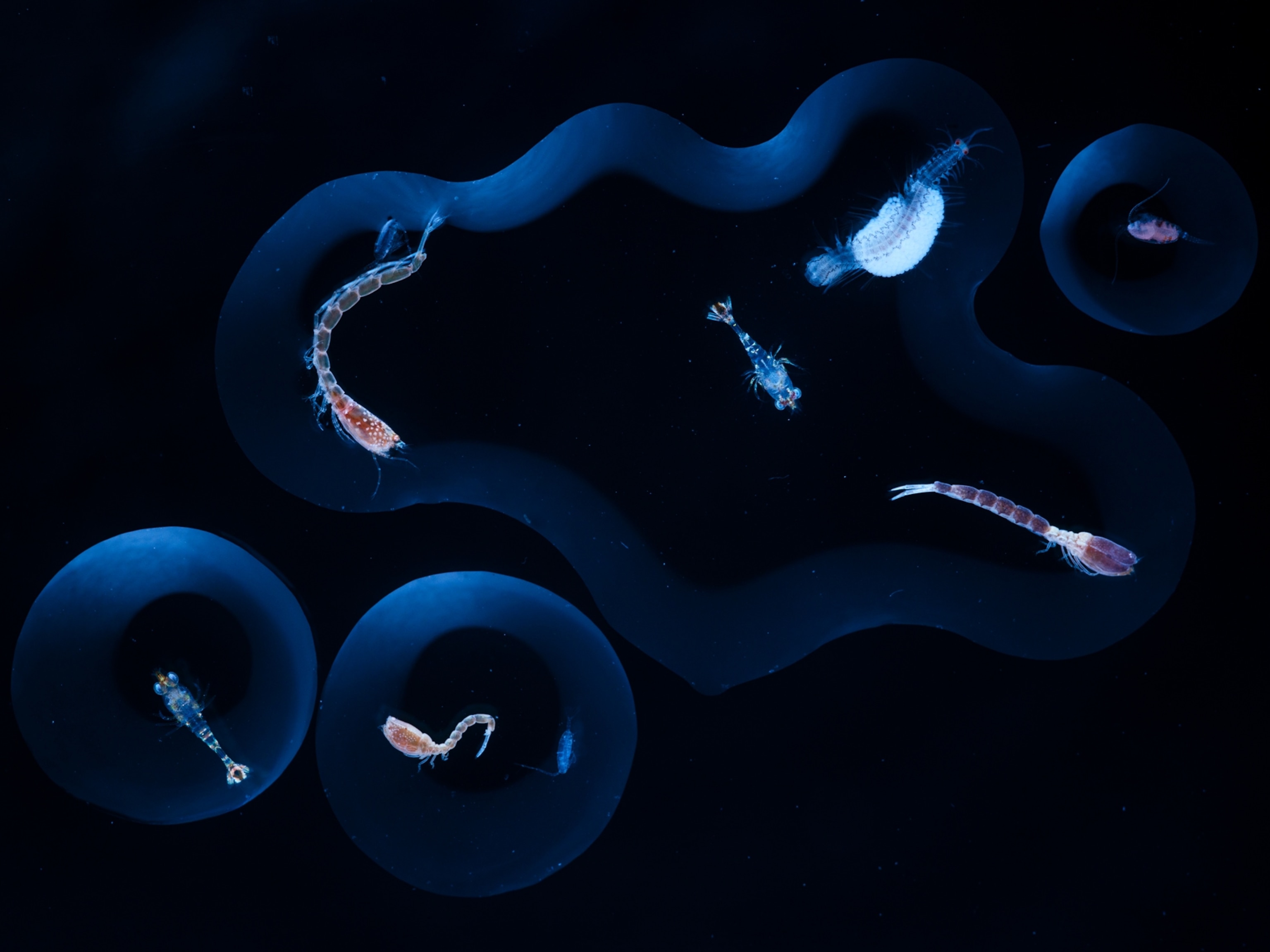
Seeing Eye to Microscopic Eye
The eye is an organ of extreme perfection. I have a strong interest in evolution, and eyes have developed stunning adaptations over time. This mayfly (above) is a male with what are called turban eyes—greatly enlarged eyes at the top of the head in the shape of a turban. The male uses his eyes to scout for the silhouette of a female in the dim light of dusk. He doesn’t even have a working mouth. If you live for only one day, as adult males usually do, you don’t need to eat. But you do need tremendous eyes to find a female before you die.
I am a cancer researcher, but I also work as a science photographer under the name “Micronaut.” The “micro” is because I specialize in shooting very small things using a scanning electron microscope at the School of Life Sciences in Muttenz, Switzerland. “Naut” is because I feel like an astronaut with the scanner, flying along and making discoveries. The scanner creates black-and-white images that can take a week for me to enhance with color. Research like this is not just scientifically important—it is extremely beautiful.

The fruit fly has a compound eye, a tightly packed collection of single lenses that gives the fly a gridlike view of the world. Scientists suspect the bristles may help protect the lenses, which have no eyelids, from dirt and debris.

Moths have huge eyes covering almost their entire, relatively small, head. For better vision in the dark, moths’ brains store up images over time, giving their photoreceptors more chances to see in dim light. (In contrast, our photoreceptors “stream” images in a constant flow, which means old images are almost immediately lost.)

Shrimps have compound eyes with square-shaped lenses. Scientists once believed that shrimps were blind. They now understand that although square lenses can’t bend light to create an image, as insect eyes do, mirrors in the box-shaped lenses do the trick.

The book scorpion, so called because it likes to live in old books, has a primitive set of eyes equipped with only a few receptors. Some species lack external eyes altogether and use receptors just below the skin to detect light.

Spider mites have a pair of eyes on each side of their bodies that can detect color and ultraviolet light waves. They rely on their vision to locate the undersides of host plant leaves in order to avoid UV radiation, which can be lethal to mites.
Martin Oeggerli’s photographs of eyes appear in the June 2015 issue of National Geographic. Oeggerli’s photo editor, Todd James, revealed more about how Oeggerli creates his colorful and stunningly detailed SEM photographs in a recent Proof post.
Related Topics
You May Also Like
Go Further
Animals
- Octopuses have a lot of secrets. Can you guess 8 of them?
- Animals
- Feature
Octopuses have a lot of secrets. Can you guess 8 of them? - This biologist and her rescue dog help protect bears in the AndesThis biologist and her rescue dog help protect bears in the Andes
- An octopus invited this writer into her tank—and her secret worldAn octopus invited this writer into her tank—and her secret world
- Peace-loving bonobos are more aggressive than we thoughtPeace-loving bonobos are more aggressive than we thought
Environment
- This ancient society tried to stop El Niño—with child sacrificeThis ancient society tried to stop El Niño—with child sacrifice
- U.S. plans to clean its drinking water. What does that mean?U.S. plans to clean its drinking water. What does that mean?
- Food systems: supporting the triangle of food security, Video Story
- Paid Content
Food systems: supporting the triangle of food security - Will we ever solve the mystery of the Mima mounds?Will we ever solve the mystery of the Mima mounds?
- Are synthetic diamonds really better for the planet?Are synthetic diamonds really better for the planet?
- This year's cherry blossom peak bloom was a warning signThis year's cherry blossom peak bloom was a warning sign
History & Culture
- Strange clues in a Maya temple reveal a fiery political dramaStrange clues in a Maya temple reveal a fiery political drama
- How technology is revealing secrets in these ancient scrollsHow technology is revealing secrets in these ancient scrolls
- Pilgrimages aren’t just spiritual anymore. They’re a workout.Pilgrimages aren’t just spiritual anymore. They’re a workout.
- This ancient society tried to stop El Niño—with child sacrificeThis ancient society tried to stop El Niño—with child sacrifice
- This ancient cure was just revived in a lab. Does it work?This ancient cure was just revived in a lab. Does it work?
- See how ancient Indigenous artists left their markSee how ancient Indigenous artists left their mark
Science
- Jupiter’s volcanic moon Io has been erupting for billions of yearsJupiter’s volcanic moon Io has been erupting for billions of years
- This 80-foot-long sea monster was the killer whale of its timeThis 80-foot-long sea monster was the killer whale of its time
- Every 80 years, this star appears in the sky—and it’s almost timeEvery 80 years, this star appears in the sky—and it’s almost time
- How do you create your own ‘Blue Zone’? Here are 6 tipsHow do you create your own ‘Blue Zone’? Here are 6 tips
- Why outdoor adventure is important for women as they ageWhy outdoor adventure is important for women as they age
Travel
- This royal city lies in the shadow of Kuala LumpurThis royal city lies in the shadow of Kuala Lumpur
- This author tells the story of crypto-trading Mongolian nomadsThis author tells the story of crypto-trading Mongolian nomads
- Slow-roasted meats and fluffy dumplings in the Czech capitalSlow-roasted meats and fluffy dumplings in the Czech capital




